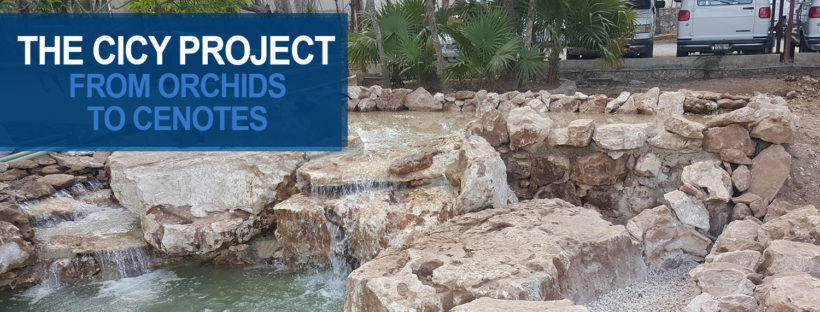The first hurdle was the design. As is common in this part of the world, the architect had specified a smooth sided shallow concrete basin that looked and worked liked a swimming pool, with standard swimming pool pumps, tiny skimm ers, a sand filter and pool returns. The problem? This was a lily pond surrounded by overhanging trees, in a public botanical garden with a shortage of help. We wouldn’t be able to count on anyone coming more than once a week, at best. Pool skimmers were not designed to handle the hundreds of leaves falling every day into the pool, and would have to be cleaned daily, as would the baskets of external pumps. No chlorine means algae in the water, which sand filters just don’t deal with well, and daily backwashing was out of the question. We needed circulation and filtration designed for ponds.
ers, a sand filter and pool returns. The problem? This was a lily pond surrounded by overhanging trees, in a public botanical garden with a shortage of help. We wouldn’t be able to count on anyone coming more than once a week, at best. Pool skimmers were not designed to handle the hundreds of leaves falling every day into the pool, and would have to be cleaned daily, as would the baskets of external pumps. No chlorine means algae in the water, which sand filters just don’t deal with well, and daily backwashing was out of the question. We needed circulation and filtration designed for ponds.
We decided on a huge PS15000 Skimmer with an oversize  net that could handle being cleaned only once a week, plumbed to a bottom drain to add flow and improve circulation. The Skimmer would accommodate two high efficiency TT9000 submersible pumps, pushing 16000 gallons per hour for only 1100 watts. One of the pumps would supply a BF3800 biological filter stuffed with Matala filter mats, to trap sediment and provide substrates for the bacteria that would convert fish wastes to plant food. The other pump would fill a chamber made of Eco-Blox water matrix blocks set on grade, capped with four inches of gravel, that would overflow to create the waterfalls. The idea behind the Eco-Blox chamber was simple, but revolutionary. All the sediments pumped into the chamber would settle out before they could flow up through the gravel. Plants set with
net that could handle being cleaned only once a week, plumbed to a bottom drain to add flow and improve circulation. The Skimmer would accommodate two high efficiency TT9000 submersible pumps, pushing 16000 gallons per hour for only 1100 watts. One of the pumps would supply a BF3800 biological filter stuffed with Matala filter mats, to trap sediment and provide substrates for the bacteria that would convert fish wastes to plant food. The other pump would fill a chamber made of Eco-Blox water matrix blocks set on grade, capped with four inches of gravel, that would overflow to create the waterfalls. The idea behind the Eco-Blox chamber was simple, but revolutionary. All the sediments pumped into the chamber would settle out before they could flow up through the gravel. Plants set with out any soil in the gravel layer on top of the chamber would extract the nitrates in the water for their survival, starving out any algae that would otherwise flourish in the pond. Because the blocks were set on grade, a simple drain at the bottom of the chamber would flush out accumulated sediments just by opening a valve, cutting maintenance of the chamber to 10 minutes once a season.
out any soil in the gravel layer on top of the chamber would extract the nitrates in the water for their survival, starving out any algae that would otherwise flourish in the pond. Because the blocks were set on grade, a simple drain at the bottom of the chamber would flush out accumulated sediments just by opening a valve, cutting maintenance of the chamber to 10 minutes once a season.
 Now that we had a workable, low maintenance solution that would handle the debris of a tropical lily pond, we could work on the design. Luckily for us, our inspiration was right around the corner. Dzibilchaltún (zee-bee-chal-TOON) was an ancient Mayan city built around a cenote (say-NO-tay), or fresh water sinkhole, that has provided water for drinking and bathing for 6000 years. Two hundred feet across and mostly only three to four feet deep, the bottom drops to 145 feet under the eastern rim, the depths visible every afternoon as the western sun slants down into the crystalline waters 15 stories down. Best of all, the center of the cenote is filled with native water lilies, in bloom when we visited. It was a sign!
Now that we had a workable, low maintenance solution that would handle the debris of a tropical lily pond, we could work on the design. Luckily for us, our inspiration was right around the corner. Dzibilchaltún (zee-bee-chal-TOON) was an ancient Mayan city built around a cenote (say-NO-tay), or fresh water sinkhole, that has provided water for drinking and bathing for 6000 years. Two hundred feet across and mostly only three to four feet deep, the bottom drops to 145 feet under the eastern rim, the depths visible every afternoon as the western sun slants down into the crystalline waters 15 stories down. Best of all, the center of the cenote is filled with native water lilies, in bloom when we visited. It was a sign!
We would build a cenote in the gardens of CICY.
Read the first post of “The CICY Project” here.
About the Author:
 DEMI FORTUNA
DEMI FORTUNA
Demi has been in water garden construction since 1986. As Atlantic’s Director of Product Information, if he’s not building water features, he’s writing or talking about them. If you have a design or construction question, he’s the one to ask.



One thought on “The CICY Project – From Orchids to Cenotes Part 2”